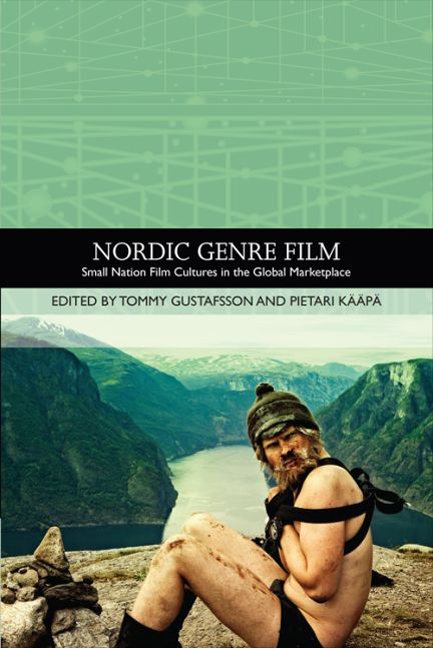Book contents
- Frontmatter
- Contents
- List of Illustrations
- List of Contributors
- Traditions in World Cinema
- Introduction: Nordic Genre Film and Institutional History
- PART I HERITAGE CINEMA AND NATIONAL NARRATIVES
- PART II CRIME AND DETECTIVE NARRATIVES
- 4 Crime Up North: The Case of Norway, Finland and Iceland
- 5 The Thrill of the Nordic Kill: The Manhunt Movie in the Nordic Thriller
- 6 Bridges and Tunnels: Negotiating the National in Transnational Television Drama
- 7 Stockholm Noir: Neoliberalism and Gangsterism in Easy Money
- 8 The Private Life of the Prime Minister? Politics, Drama and Documentary in Pääministeri and Palme
- PART III NORDIC OPTIMISM: ROAD MOVIES, COMEDIES AND MUSICALS
- PART IV NORDIC HORRORS
- PART V GENRE BENDERS
- Index
4 - Crime Up North: The Case of Norway, Finland and Iceland
from PART II - CRIME AND DETECTIVE NARRATIVES
Published online by Cambridge University Press: 25 October 2017
- Frontmatter
- Contents
- List of Illustrations
- List of Contributors
- Traditions in World Cinema
- Introduction: Nordic Genre Film and Institutional History
- PART I HERITAGE CINEMA AND NATIONAL NARRATIVES
- PART II CRIME AND DETECTIVE NARRATIVES
- 4 Crime Up North: The Case of Norway, Finland and Iceland
- 5 The Thrill of the Nordic Kill: The Manhunt Movie in the Nordic Thriller
- 6 Bridges and Tunnels: Negotiating the National in Transnational Television Drama
- 7 Stockholm Noir: Neoliberalism and Gangsterism in Easy Money
- 8 The Private Life of the Prime Minister? Politics, Drama and Documentary in Pääministeri and Palme
- PART III NORDIC OPTIMISM: ROAD MOVIES, COMEDIES AND MUSICALS
- PART IV NORDIC HORRORS
- PART V GENRE BENDERS
- Index
Summary
Although the great local and global interest in Nordic noir bears witness to a remarkable change in the national cinemas of the Nordic countries, certain things remain the same: Norway, Finland and Iceland are overshadowed by Denmark and Sweden. With its roots in the police procedurals of writer-couple Maj Sjowall and Per Wahloo, a form later revitalised by Henning Mankell, not to mention the unparalleled success of Stieg Larsson's Millennium trilogy (a police procedural in journalism ‘disguise’), Sweden was and remains the centre of Scandinavian crime fiction. Recently, however, Danish crime films and television series, including the influential police procedural The Killing (Forbrydelsen, Soren Sveistrup, 2007–12), have given adaptations of said Swedish crime series good competition for the primacy of Nordic noir. The Bridge (Broen|Bron, Hans Rosenfeldt, 2011–) could be said to consolidate their mutual supremacy as Danish and Swedish police officers (and television producers) join hands when a body is found exactly halfway across the Oresund bridge connecting the two countries – leaving the other Nordic countries watching from a distance. Norway, Finland and Iceland have, however, not remained out of it altogether and on occasion managed to grab the spotlight, as evidenced by films such as Jar City (Mýrin, Baltasar Kormakur, 2006) and Headhunters (Hodejegerne, Morten Tyldum, 2011), the latter based on a novel by the Norwegian Jo Nesbo (2011) – arguably Larsson's heir to the Scandinavian crime fiction crown.
As these opening remarks suggest, it is impossible to discuss contemporary Nordic crime cinema and television without taking into account the ties to its literary counterpart – notably most of the films discussed in this chapter are adaptations. One of the benefits of the increasingly popular label Nordic Noir – English home video distributor Arrow Films even offers T-shirts marked thus for sale – is that it is not medium specific and perhaps even emphasises film due to its film noir connotations while ‘fiction’ (as in Scandinavian crime fiction) is conventionally limited to literature. Nordic noir is indeed a constellation of texts stemming from novels, television and cinema, tied together in various and often blurred ways. The coinage is, however, somewhat misleading.
- Type
- Chapter
- Information
- Nordic Genre FilmSmall Nation Film Cultures in the Global Marketplace, pp. 61 - 75Publisher: Edinburgh University PressPrint publication year: 2015



